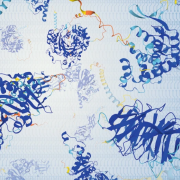Nature Methods has named protein structure prediction the Method of the Year 2021.
If the Earth moves for you, among other reasons, the causes can be geologic or romantic. In science, in the context of predicting protein structure, you might have felt the ground tremble in late 2020 as you perused the results of the 14th Critical Assessment of Protein Structure Prediction (CASP). In this competition, scientists regularly test the prowess of their methods that computationally predict the intricate twirly-curly three-dimensional (3D) structure of a protein from a sequence of amino acids.
A pleasant frisson may have set in more recently as you browsed the new and rapidly growing AlphaFold Protein Structure Database or perused papers1,2,3 about a method called AlphaFold and its application to the entire human proteome, or when you dug into the code that drives this inference engine, with its neural network architecture that yields the 3D structure of proteins from a given amino acid sequence. The team behind AlphaFold is DeepMind Technologies, launched as an AI startup in 2010 by Demis Hassabis, Shane Legg and Mustafa Suleyman and now part of Alphabet after being acquired by Google in 2014. DeepMind has presented AlphaFold14 and AlphaFold2 and, more recently, AlphaFold-Multimer5 for predicting the structures of known protein complexes.
AlphaFold has received much attention, but there are many other recent tools from academic labs, such as RoseTTAFold6, a method with a ‘three-track’ network architecture developed in the lab of David Baker and colleagues at the University of Washington along with academic teams around the world. It can be used to, for example, predict protein structures and generate models of protein-protein complexes, too. In their paper, the authors note that they had been “intrigued” by the DeepMind results and sought to increase the accuracy of protein structure prediction as they worked on their architecture...
Read the full story on Nature.com's website using the link below.

